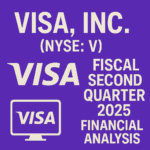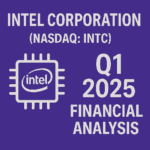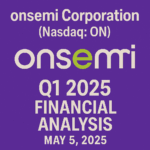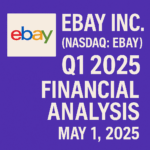Axcelis Technologies, Inc. (NASDAQ: ACLS)
Q1 2025 Financial Analysis | May 6, 2025
Executive Summary
Axcelis Technologies reported Q1 2025 results demonstrating strong profitability despite challenging market conditions, with revenue of $192.6 million, down 24% year-over-year. The company maintained solid margin performance with GAAP gross margin of 46.1% and non-GAAP gross margin of 46.4%. Despite the revenue decline, Axcelis delivered GAAP net income of $28.6 million ($0.88 per diluted share) and non-GAAP net income of $33.8 million ($1.04 per diluted share), while continuing to invest in innovation and executing its share repurchase program.
Q1 2025 Highlights
Financial Performance
Axcelis Technologies reported Q1 2025 revenue of $192.6 million, a 24% decrease from $252.4 million in Q1 2024. This decline primarily reflects a moderation in customer investments and a more uncertain broader economic backdrop affecting the semiconductor equipment industry. Product revenue decreased to $182.8 million from $243.4 million in the prior year period, while services revenue increased slightly to $9.7 million from $9.0 million.
Despite the revenue decline, the company maintained solid gross margin performance with a GAAP gross margin of 46.1%, a slight improvement from 46.0% in Q1 2024. On a non-GAAP basis, gross margin expanded to 46.4% from 46.1% in the prior year period. This margin resilience demonstrates the company’s ability to manage costs effectively even during periods of lower revenue.
Operating income decreased to $29.2 million (15.1% margin) from $56.5 million (22.4% margin) in Q1 2024, reflecting the impact of lower revenue. On a non-GAAP basis, operating income was $35.2 million (18.3% margin) compared to $60.8 million (24.1% margin) in the prior year period. Total operating expenses remained relatively flat at $59.6 million compared to $59.5 million in Q1 2024, with increased investments in research and development offset by reductions in sales and marketing expenses.
Net income for the quarter was $28.6 million, or $0.88 per diluted share, compared to $51.6 million, or $1.57 per diluted share, in Q1 2024. On a non-GAAP basis, net income was $33.8 million, or $1.04 per diluted share, compared to $55.2 million, or $1.68 per diluted share, in the prior year period. The decline in net income primarily reflects the lower revenue and operating income, partially offset by higher interest income and lower tax expenses.
Adjusted EBITDA was $39.5 million (20.5% margin), compared to $64.5 million (25.6% margin) in Q1 2024, representing a 39% decrease year-over-year. Despite this decline, the company maintained strong cash generation and financial discipline, concluding the quarter with a robust cash position and no debt.
Balance Sheet & Cash Flow
| Balance Sheet Items | March 31, 2025 | Dec 31, 2024 | Change |
|---|---|---|---|
| Cash and Cash Equivalents | $184.0M | $123.5M | +$60.5M |
| Short-term Investments | $403.1M | $447.8M | -$44.7M |
| Accounts Receivable, net | $164.9M | $203.1M | -$38.2M |
| Inventories, net | $295.9M | $282.2M | +$13.7M |
| Total Assets | $1,340.6M | $1,348.8M | -$8.2M |
| Total Liabilities | $313.4M | $336.0M | -$22.6M |
| Total Stockholders’ Equity | $1,027.2M | $1,012.8M | +$14.4M |
Axcelis maintained a strong balance sheet with total assets of $1.34 billion as of March 31, 2025, relatively flat compared to $1.35 billion at the end of 2024. The company’s liquidity position remained robust, with cash and cash equivalents increasing to $184.0 million from $123.5 million at the end of 2024, while short-term investments decreased to $403.1 million from $447.8 million. This shift reflects the company’s cash management strategy during the quarter.
The company generated $39.8 million in cash from operating activities during Q1 2025, compared to $42.2 million in Q1 2024. This solid cash generation despite lower revenue demonstrates the company’s efficient working capital management and resilient business model. Capital expenditures increased to $5.0 million from $1.6 million in the prior year period, primarily related to investments in property, plant, and equipment to support long-term growth initiatives.
Axcelis continued its share repurchase program, buying back $18.2 million of common stock during Q1 2025, compared to $15.0 million in Q1 2024. The share count decreased to 32.1 million shares outstanding as of March 31, 2025, from 32.4 million at the end of 2024. This ongoing share repurchase activity reflects the company’s confidence in its long-term growth prospects and commitment to returning value to shareholders.
Inventory levels increased slightly to $295.9 million from $282.2 million at the end of 2024, representing a strategic decision to maintain adequate component supplies in the current challenging supply chain environment. Accounts receivable decreased to $164.9 million from $203.1 million, reflecting the lower revenue levels as well as improved collections.
The company’s financial position remains solid with no debt, providing significant flexibility to navigate market uncertainties while continuing to invest in innovation and strategic initiatives. Total stockholders’ equity increased to $1.03 billion from $1.01 billion at the end of 2024, reflecting the company’s profitability despite the challenging market conditions.
Revenue Breakdown
| Revenue Category | Q1 2025 ($M) | Q1 2024 ($M) | YoY Change |
|---|---|---|---|
| Product Revenue | $182.8 | $243.4 | -24.9% |
| Services Revenue | $9.7 | $9.0 | +7.8% |
| Total Revenue | $192.6 | $252.4 | -23.7% |
Axcelis’s revenue mix in Q1 2025 continued to be dominated by product revenue, which accounted for 94.9% of total revenue at $182.8 million, compared to $243.4 million (96.5% of total revenue) in Q1 2024. The 24.9% year-over-year decline in product revenue primarily reflects the moderation in customer investments and a more uncertain economic environment affecting capital equipment spending by semiconductor manufacturers.
Services revenue increased by 7.8% to $9.7 million from $9.0 million in Q1 2024, representing 5.1% of total revenue compared to 3.5% in the prior year period. This growth demonstrates the company’s focus on expanding its service offerings and highlights the relative stability of the services business even during periods of slower capital equipment sales.
The company’s revenue performance reflects broader industry trends, with semiconductor manufacturers becoming more cautious in their capital equipment investments amidst global economic uncertainties and trade tensions. The increased diversification of revenue through higher services contribution provides some buffer against volatility in capital equipment spending, though product sales remain the primary driver of Axcelis’s financial results.
While the company does not disclose detailed geographic or product line breakdowns in its quarterly releases, management commentary indicated that the moderation in customer investments was broadly based across regions. Axcelis continues to focus on its core ion implantation systems, which are critical for semiconductor manufacturing processes, and is positioning itself to capitalize on long-term growth opportunities despite near-term challenges.
Cost Structure & Margin Analysis
| Cost & Margin Metrics | Q1 2025 | Q1 2024 | Change |
|---|---|---|---|
| Cost of Revenue | $103.8M (53.9%) | $136.3M (54.0%) | -23.8% |
| Research & Development | $27.1M (14.1%) | $25.7M (10.2%) | +5.4% |
| Sales & Marketing | $15.1M (7.8%) | $17.4M (6.9%) | -13.2% |
| General & Administrative | $17.4M (9.0%) | $16.4M (6.5%) | +6.1% |
| GAAP Gross Margin | 46.1% | 46.0% | +0.1pts |
| Non-GAAP Gross Margin | 46.4% | 46.1% | +0.3pts |
| GAAP Operating Margin | 15.1% | 22.4% | -7.3pts |
| Non-GAAP Operating Margin | 18.3% | 24.1% | -5.8pts |
Axcelis demonstrated effective cost management in Q1 2025, with cost of revenue decreasing 23.8% year-over-year to $103.8 million, largely in line with the 23.7% revenue decline. This resulted in a slight improvement in GAAP gross margin to 46.1% from 46.0% in Q1 2024, while non-GAAP gross margin increased to 46.4% from 46.1%. The margin improvement despite revenue declines reflects the company’s focus on operational efficiency and cost optimization.
Research and development expenses increased by 5.4% to $27.1 million (14.1% of revenue) from $25.7 million (10.2% of revenue) in Q1 2024, highlighting the company’s continued commitment to innovation despite market challenges. This strategic investment is aimed at maintaining Axcelis’s competitive position and capturing long-term growth opportunities in the semiconductor equipment market.
Sales and marketing expenses decreased by 13.2% to $15.1 million, while general and administrative expenses increased by 6.1% to $17.4 million. As a percentage of revenue, these expenses increased due to the lower revenue base, with sales and marketing at 7.8% (vs. 6.9% in Q1 2024) and general and administrative at 9.0% (vs. 6.5% in Q1 2024).
The combination of relatively stable gross margins and increased operating expenses as a percentage of revenue led to a decline in GAAP operating margin to 15.1% from 22.4% in Q1 2024, and non-GAAP operating margin to 18.3% from 24.1%. Despite this decline, the company’s operating profitability remained solid, reflecting its resilient business model and effective cost management in a challenging environment.
Adjusted EBITDA margin decreased to 20.5% from 25.6% in Q1 2024, primarily due to the lower revenue and higher operating expenses as a percentage of revenue. The company’s restructuring initiatives, which resulted in charges of $1.1 million during the quarter, are expected to drive future cost efficiencies and help maintain profitability even in periods of slower growth.
Outlook & Guidance
For the second quarter of 2025 ending June 30, 2025, Axcelis provided the following guidance:
- Revenue expected to be approximately $185 million, representing a further sequential decline of approximately 4% from Q1 2025
- GAAP earnings per diluted share projected to be approximately $0.57
- Non-GAAP earnings per diluted share expected to be approximately $0.73
The Q2 2025 guidance reflects continued caution regarding customer investments in the semiconductor equipment industry. The projected sequential decline in revenue suggests that market conditions remain challenging, with semiconductor manufacturers maintaining a cautious approach to capital expenditures amid economic uncertainties and trade tensions.
While the company did not provide specific full-year guidance, management commentary indicated that Axcelis is well positioned to navigate the current market environment with its agile global manufacturing and supply chain footprint. This operational flexibility, combined with the company’s strong balance sheet and ongoing innovation initiatives, positions Axcelis to maintain profitability while continuing to invest in future growth opportunities.
Management expressed confidence in the company’s ability to execute in a dynamic macroeconomic and global trade environment, emphasizing the resilience of the operating model and the strategic importance of continued investment in innovation. The expected non-GAAP operating margin for Q2 2025, while not explicitly stated, can be inferred to be lower than Q1 2025 based on the projected EPS decline.
The company’s approach to shareholder returns is expected to remain consistent, with ongoing share repurchases in an “opportunistic but disciplined manner” alongside continued investments in the business. This balanced capital allocation strategy reflects management’s confidence in the company’s long-term prospects while acknowledging near-term market challenges.
Strategic Initiatives
Axcelis continues to execute on several strategic initiatives designed to drive long-term growth and enhance its competitive position in the semiconductor equipment market:
- Innovation Investment: Increased R&D spending by 5.4% year-over-year to $27.1 million despite revenue declines, reflecting the company’s commitment to technology leadership in ion implantation systems
- Operational Optimization: Ongoing refinement of the global manufacturing and supply chain footprint to enhance agility and resilience in a dynamic market environment
- Service Business Expansion: Growth in services revenue by 7.8% year-over-year, providing a more stable revenue stream to complement the more cyclical product business
- Cost Management: Implementation of global cost-saving initiatives, including restructuring programs that resulted in $1.1 million in charges during Q1 2025
- Capital Return: Continuation of the share repurchase program, with $18.2 million of common stock repurchased during Q1 2025
The company’s strategic focus on maintaining and enhancing its technology leadership in ion implantation systems remains central to its long-term value proposition. Ion implantation is a critical and enabling step in the semiconductor manufacturing process, and Axcelis aims to capitalize on this essential position in the semiconductor equipment value chain.
Management emphasized the importance of the company’s agile global manufacturing and supply chain footprint, which has been optimized over the past few years. This operational flexibility provides a competitive advantage in navigating market volatility and addressing customer needs efficiently across different regions and market conditions.
The company’s balanced approach to capital allocation, combining investments in innovation, operational improvements, and shareholder returns through share repurchases, reflects a commitment to both near-term shareholder value and long-term growth potential. With a debt-free balance sheet and strong cash position, Axcelis has significant financial flexibility to execute on these strategic priorities even during periods of market uncertainty.
Risks & Opportunities
Opportunities
Risks
Conclusion
Strengths
- Maintained solid gross margins despite revenue decline
- Strong balance sheet with cash and no debt
- Continued investment in R&D despite market challenges
- Growing services business providing revenue diversification
- Operational flexibility from optimized global footprint
Areas to Monitor
- Continued revenue decline expected in Q2 2025
- Rising operating expenses as a percentage of revenue
- Inventory management in a slower growth environment
- Impact of global trade tensions on semiconductor equipment market
- Execution of cost-saving initiatives and restructuring
Summary
Axcelis Technologies delivered Q1 2025 results that demonstrated resilient profitability despite challenging market conditions. While revenue declined 24% year-over-year to $192.6 million, the company maintained solid gross margins and delivered GAAP net income of $28.6 million ($0.88 per diluted share) and non-GAAP net income of $33.8 million ($1.04 per diluted share).
The company’s strategic focus on operational efficiency, innovation investment, and financial discipline is evident in its performance. Despite revenue headwinds, Axcelis increased R&D spending to support future growth, maintained gross margin performance, and continued its share repurchase program. The strong balance sheet, with no debt and a robust cash position, provides significant flexibility to navigate market uncertainties.
Looking ahead, Axcelis expects continued market challenges in Q2 2025, with projected revenue of approximately $185 million and lower earnings per share. However, management expressed confidence in the company’s ability to execute in a dynamic environment, leveraging its agile global manufacturing and supply chain footprint that has been optimized over the past few years.
While near-term revenue growth may remain constrained by moderation in customer investments and broader economic uncertainties, Axcelis appears well-positioned to maintain profitability and capture long-term growth opportunities in the semiconductor equipment market. The company’s essential role in semiconductor manufacturing through its ion implantation systems, combined with its financial strength and operational flexibility, provides a solid foundation for navigating the current market cycle.






